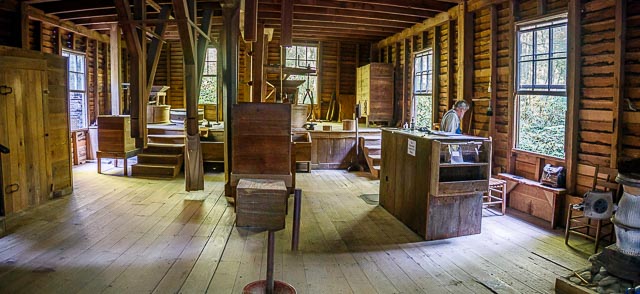Mingus Mill Great Smoky Mountains National Park

Mingus Mill provides a rare opportunity for Park visitors to get a glimpse what life was like when the North American continent was being settled. The mill is staffed by knowledgeable caretakers from April through October (and also weekends in November) who are happy to share information about the mill and perform demonstrations. Cookbooks, lye soap, wheat flour, corn meal, and informative brochures can be purchased during opening hours.
During the winter months, the interior of the mill is closed to the public, however visitors are welcome to meander along the paths and structures outside the mill.
Mingus Mill was built in 1886 by the millwright Sion Thomas Early of Sevier County, Tennessee. Early did the work for John Mingus, a son of John Jacob Mingus. Early completed the mill in three months for a cost of $600. The mill operated at wholesale and retail levels until the National Park Service purchased the property in 1934. The mill was restored in 1937, closed during World War II, and reopened in 1968.
Water diverted from Mingus Creek via a sluice (canal) and a wooden flume turns two turbines which provide power to the mill. An iron shaft connects the turbines to grindstones on the first floor and a wheat cleaner and bolting chest on the second floor (the latter two via a series of pulleys). Wheat or corn is first transported by bucket belt to the wheat cleaner, which is essentially a fan which clears the grain of dirt and excess material, and then drops it back to the first floor. The cleaned grain is then fed into the grindstones, which break it down into flour (or cornmeal). The flour is then transported back to the second floor and fed into the bolting chest, which uses bolts of progressively coarser cloth to separate the flour into different grades.
While the mill’s turbine is not as photogenic as the overshot wheels that power mills such as the Cable Mill at Cades Cove, it was more efficient and required less water power to operate. The turbine generated approximately 11 horsepower (8.2 kW) turning at 400 rpm.
Aden Carver, who arrived in Oconaluftee in the mid-19th century, helped Early build the mill in 1886. When the mill was restored in 1937, Carver, then in his 90s, aided in its restoration.
Where it is:
The mill is located just off of Highway 441 (Newfound Gap Road). Mingus Mill is just short walk down a trail from the parking lot.
Directions:
From Cherokee, NC and the Oconaluftee visitor’s center, take 441 into the Great Smoky Mountains National Park. The mill is just a few miles past the visitor center on the left. You’ll see signs.
From Gatlinburg, TN take 441 into the Great Smoky Mountains National Park. Pass Sugarlands Visitor Center and travel about 30 miles through the park, until you see the signs for Mingus Mill on your right. If you reach the Oconaluftee Visitor center, you went too far.
Maps:
Interactive Google Map
Use the map + – controls to zoom in and out, click and drag the to move the map, use the Map drop-down to change to “Map”, “Satellite”, “Hybrid”, or “Terrain” views. Drag the little man icon from the upper left corner to a map location for street level view.
Hours:
Location Contact Information:
By Mail
Great Smoky Mountains National Park
107 Park Headquarters Road
Gatlinburg, TN 37738
By Phone
Recorded information: (865) 436-1200
Road Updates: (865) 436-1200 select 2, then 2 again
Emergencies: 911
Facilities:
Photo Gallery
Click Here for full page gallery
More Photographic Destinations in North Carolina Interactive Google Map
Use the map + – controls to zoom in and out, use the Map drop-down to change to “Map”, “Satellite”, “Hybrid”, or “Terrain” views. Drag the little man icon from the upper left corner to a map location for street level view. Click on a pushpin for more information about the Photographic Destination, then click on the title to go to the location page.
Click Here for Photographic Destinations by State





